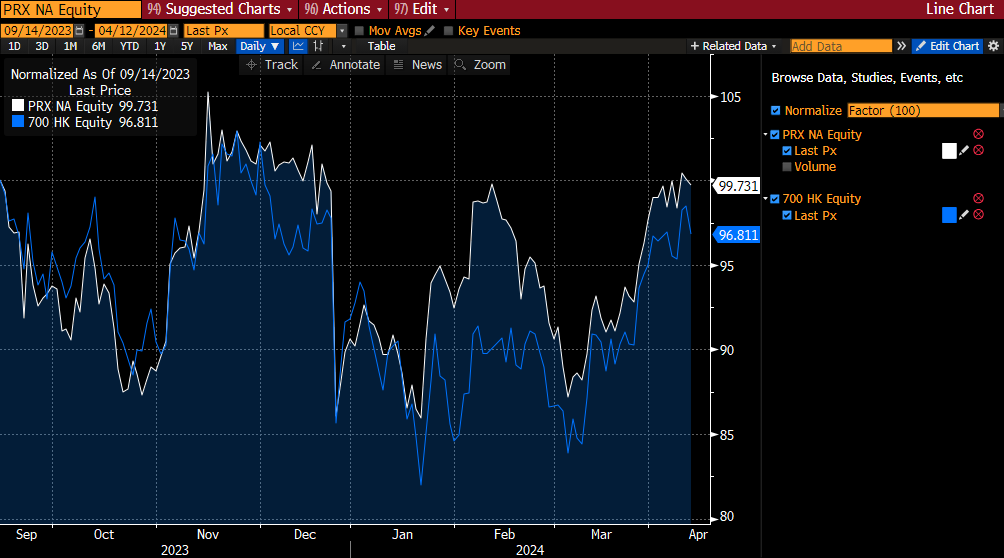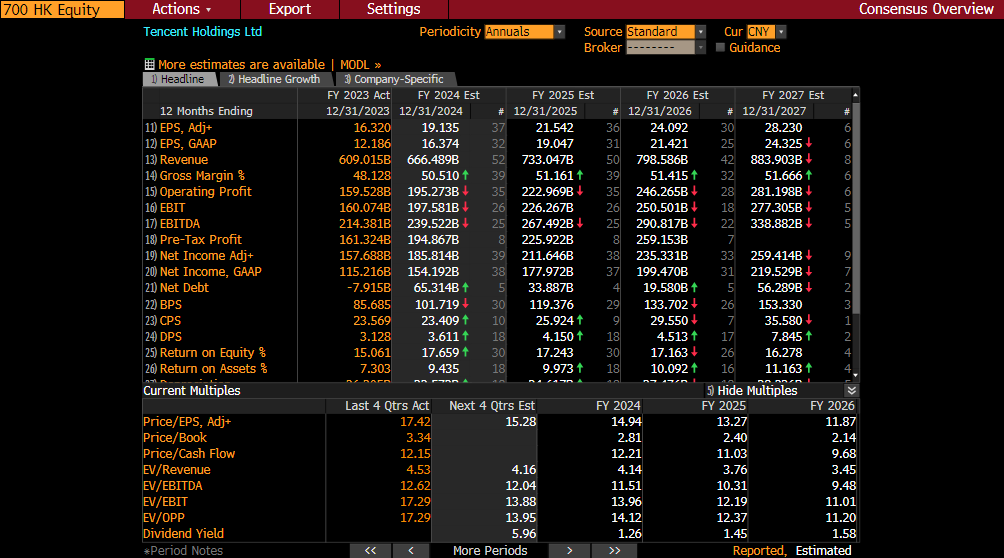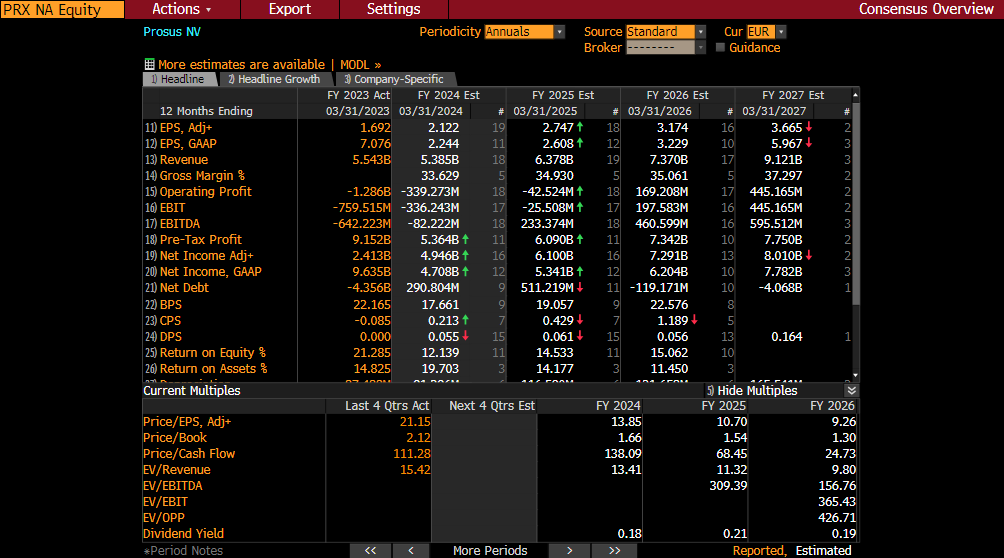AMZN – Q1 results, only getting started
GSK – Upgrades FY guidance
HLN – Q1 update, on track for FY
IDS – Constructive union comments
KYGA – Q1 update
PCA – Nearing the finish line
RYA – Passenger data, good start to FY25
SN/ – Q1 update, solid start to 2024
SPDI – Dutch associate’s FY results
GSK – Upgrades FY guidance
GSK released an upbeat Q1 update on Wednesday. The Group has had a strong start to the year, with Q1 sales of £7.4bn +10% y/y (+13% y/y ex-COVID). This revenue growth was broad-based, with Vaccine sales +16% y/y, Specialty Medicines +17% y/y and General Medicines +1% y/y. Core operating profit was +27% y/y (+35% y/y ex-COVID), with similar momentum from EPS. GSK also reported a strong cash flow performance, with operating cash flow of £1.1bn and £0.3bn of free cash flow. Net debt was £15bn at end-Q1, a £3bn reduction vs end-Q1 2023 and -£0.1m from end-2023 (the latter as free cash flow and Haleon sales proceeds were mostly offset by the £719m Aiolos acquisition and £568m of dividend payments). As has been documented here, the Group has made very strong progress across its pipeline of vaccines and specialty medicines in the period. GSK has upgraded its FY sales (now seen towards the upper part of the 5-7% range) and EPS (now 8-10%, was 6-9%) guidance. It continues to guide to a 60p FY dividend, with 15p of this in respect of Q1 performance. There was no ‘new news’ on Zantac. At the end of Q1 GSK had 72 vaccines and specialty medicines in its pipeline. All in all, a very bright start to 2024, with a welcome upgrade to FY guidance. I don’t see the momentum and/or the attractive pipeline reflected in GSK’s very undemanding valuation of 9.8x consensus 2025 earnings. The stock also yields 3.8%.
KYGA – Q1 update
Kerry Group released its Q1 Interim Management Statement on Thursday. This revealed a “good start to the year”, with Group volumes +1.9% (Taste & Nutrition was +3.1% y/y), although pricing headwinds (Group -5.3% / T&N -3.9%) were evident. Net M&A was a further 5.1% headwind, while knocked the topline by a further 140bps, resulting in overall revenues -9.9% y/y. Nonetheless, cost containment meant that EBITDA margin advanced 140bps (across both Group and T&N). Dairy Ireland EBITDA margin was +70bps. The Group has launched a new €300m share buyback, which follows the previous €300m programme that ran from November 2023 to late April 2024. Since the start of Q2 the Group has completed the acquisition of part of the global lactase enzyme business of Novonesis. Net debt at end-March was €1.7bn, €1.85bn pro-forma for the Novonesis transaction, which leaves ample scope for further earnings-enhancing bolt-on M&A, even after taking the new €300m buyback into account. While Kerry struck a relatively downbeat tone in its [near term] outlook statement “well positioned for volume growth and good margin expansion, while recognising consumer demand remains relatively subdued”, the long term drivers of demand for Kerry – nutrition, sustainability, ageing and more prosperous societies – remain very much intact. The Group has also nudged up its FY adjusted EPS growth guidance to 5.5-8.5% (was 5-8%), reflecting the impact of the new share buyback programme. It’s not cheap, but Kerry isn’t overly expensive either at 16.2x consensus 2025 earnings. The stock yields 1.7% at these levels.
HLN – Q1 update, on track for FY
Haleon released its Q1 trading statement on Wednesday. This showed a solid start to the year, with organic revenue +3% (price +5%/volume/mix -2%). On a reported basis, revenue of £2.9bn was -2% due mainly to FX and, to a lesser extent, an M&A drag. Performance was, pleasingly, led by the Power Brands, which had organic revenue growth of 5.2%. Earnings momentum was noticeably stronger, with organic profit growth of 12.8%, and the adjusted operating profit margin of 24.2% was +220bps. As previously announced, the Group repurchased 102m shares for £315m during Q1, which should help with EPS. The Group continues to target productivity improvements. FY guidance is unchanged at organic revenue growth of 4-6% and operating profits to outpace that rate of increase. Haleon isn’t cheap in absolute terms, on 16.8x consensus 2025 earnings, but its portfolio of brands is strongly cashflow generative, allowing scope for re-ratings through a combination of buybacks, M&A and deleveraging.
SN/ – Q1 update, solid start to 2024
Smith + Nephew reported Q1 results on Wednesday. Revenue of $1.4bn was +2.9% underlying (+2.2% reported after taking an FX headwind into consideration), in-line with expectations. Growth was driven by Orthopaedics (+4.4%) and Sports Medicine & ENT (+5.5%), with Advanced Wound Management -2.0%). SN/ has reiterated its FY guidance of underlying revenue growth of 5-6% and a trading profit margin of at least 18%. The Group says that its 12 point strategic plan to uplift performance “is on-track”, adding “we are confident in our outlook and look forward to all three of our business units contributing as we deliver another year of strong revenue growth”. Smith + Nephew is cheap, trading on 12.2x consensus 2025 earnings and yielding 3.4%.
AMZN – Q1 results, only getting started
Amazon released its Q1 results on Tuesday. As expected, these showed strong momentum, with net sales +13% y/y to $143bn and, within that, there was broad-based improvement (North America +12% y/y to $86bn; International +10% y/y to $32bn; and AWS +17% y/y to $25bn). Operating income soared to $15.3bn from $4.8bn in the prior year period, reflecting cost reduction efforts and operating leverage effects. AMZN’s improving cash flow is another key highlight, with free cash flow of +$50bn in the 12 months to end-March vs an outflow of $10bn in the 12 months to end-March 2023. The results release showcases the customer improvements that the Group continues to make – across the 60 largest US metro areas, nearly 60% of Prime orders arrived the same or the next day. The Group has recently launched a grocery subscription service for unlimited delivery on orders >$35 from Whole Foods, Amazon Fresh and local grocery and specialty retailers in more than 3,500 US urban cities. AMZN is putting in place measures to support further AWS growth (the business is now running at an annualised $100bn of revenue), including investing $10bn on two new data centre complexes in Mississippi. AMZN guides to Q2 net sales of $144-149bn, +7-11% y/y, although this is only modestly above the Q1 outturn so I wonder if there is upside risk to this, with Q2 operating income of $10-14bn guided (below Q1 2024’s outturn). Irrespective of whether or not the Q2 guidance proves light, I think Amazon is only at the early stages of fulfilling its potential – International sales are only a third of the US; while AWS’ $100bn annualised revenue run-rate seems very low compared to the medium/long-term direction of travel for tech spend. Bloomberg consensus has AMZN on an undemanding 2025 EV/EBITDA multiple of 12.3x.
IDS – Constructive union comments
The weekend papers reported that the CWU, which represents 110,000 Royal Mail workers, is open to changes to the universal service obligation (USO) rules. IDS wants to axe Saturday deliveries of second class non-parcel post to pare costs – Royal Mail is set up to handle 20bn letter volumes annually but currently only forwards 7bn letters. The CWU helpfully stated that the current six-day-a-week service is “no longer financially viable”. The union’s change of heart seems to have been sparked by the £3bn takeover approach for IDS from Czech billionaire Daniel Kretinsky. Interestingly, by keeping a six-day-a-week first class letter service, this would remove the need for parliamentary approval for changes to the USO. Ofcom approval would still be required, but on this I note that the regulator has taken an economically rational approach on the matter up to now. The Labour government-in-waiting will also be mindful of the CWU’s constructive comments, likely reducing political risks. A structural reduction in costs would be clearly very helpful for IDS’ earnings outlook. IDS is very cheap, trading on 10.7x consensus 2025 earnings, and it is expected to yield 3.7% next year.
PCA – Nearing the finish line
Palace Capital announced on Monday that it has sold Boulton House, a central Manchester office building, for £8.75m which is at the end-March 2024 book value but 2.8% below the end-September 2023 book value of £9.0m. Management says the disposal “demonstrates continuing progress in our disposal strategy and on completion will provide additional cash for returning to shareholders in due course”. By my maths, since 1 April 2023 PCA has sold 24 investment properties at c.2% above the end-March 2023 valuation. This leaves PCA with office buildings in York, Fareham, Leamington Spa, Exeter, Newcastle; leisure assets in Northampton and Halifax; a retail premises in Dartford; and a small number of apartments in York. FY results in June will provide an end-March 2024 NAV figure, with a tender offer in the near term set to provide liquidity to investors wishing to check out early. PCA was trading at 248p earlier today versus the latest (end-September) NTA per share of 294p.
RYA – Passenger data, good start to FY25
Ryanair released its April passenger data on Thursday, and this show growth of 8% y/y to 17.3m guests last month, which is of course the first month of its FY 2025. The load factor was 92%, -2pc y/y. On a rolling 12 month basis, RYA has carried 185.0m PAX, +9% y/y, on loads of 93% (-1pc y/y). Overall, a solid start to the new financial year. Ryanair is very cheap, trading on just 9.2x consensus FY 2025 earnings and yielding 2.5%.
SPDI – Dutch associate’s FY results
Arcona, the Dutch-listed Eastern European focused real estate business that SPDI is the largest (22%) shareholder in, released its FY results on Tuesday. The Group reported a modest (€183k) profit for 2023, marking a welcome reversal from the prior year’s net loss of €4.4m. On a LFL basis, the fair value of its portfolio was +0.6% y/y, however the Group’s Triple NAV (NNNAV) per share decreased 7.5% to €10.93 due to full recognition of deferred taxes arising from plans for an accelerated sales programme for its portfolio. Interest costs rose from €2.2m to €3.1m due to the rate environment, and while this led to technical covenant breaches, the Group has secured waivers for all of these. Importantly, the LTV has improved from 43.6% at end-2022 to 39.5% at end-2023, and the planned further disposals will allow for deleveraging and a buyback (personally I don’t think they should be doing the buyback until the LTV is much lower, but Arcona’s shareholders seem to disagree). Management expects “improved market conditions and lower financing costs to support our operational performance and transaction activities in 2024”. At the NNNAV per share SPDI’s direct shareholding in Arcona is worth €12m, which is highly material relative to SPDI’s latest (end-June 2023) published NAV of €13m. I note that SPDI (market cap £5m) is to hold a shareholder call on 9 May, which will hopefully shed some light on management’s strategy for value realisation, given that the market is currently assigning a negative value on SPDI’s non-Arcona net assets. SPDI reports its FY results next month.


